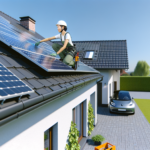Introduction to Solar-Powered Devices
The Rise of Solar Technology
In recent decades, solar panel technology has evolved significantly, allowing for remarkable innovation. Advances in solar cell efficiency, the introduction of new and more abundant materials, and improvements in manufacturing techniques have all contributed to making solar photovoltaics more accessible and efficient. For instance, solar panel efficiency rates have skyrocketed from around 10% in the early days to over 20% or even 25% today. This means that modern solar panels can convert nearly a quarter of the sunlight they receive into clean, renewable energy. Additionally, the development of flexible and lightweight solar panels has opened up new possibilities for their application in diverse settings, from portable devices to curved surfaces.
Benefits of Solar-Powered Devices
Solar-powered devices offer numerous benefits that make them an attractive option for both individuals and businesses. Here are some key advantages:
- Environmental Impact: Solar energy is a clean and renewable source of power that reduces greenhouse gas emissions and dependence on fossil fuels.
- Cost Savings: Once installed, solar panels can significantly reduce or even eliminate electricity bills, providing long-term financial savings.
- Energy Independence: Solar power allows for energy independence, reducing reliance on the grid and providing a reliable source of electricity in remote or off-grid locations.
- Low Maintenance: Solar panels require minimal maintenance, with most systems lasting 25 years or more with little degradation in performance.
- Versatility: Solar technology can be integrated into a wide range of applications, from residential rooftops to portable chargers and large-scale solar farms.
Why Customize Your Solar Solutions?
Customizing your solar solutions can provide several unique advantages tailored to your specific needs and circumstances:
- Optimized Performance: By designing a system that meets your exact power requirements, you can ensure optimal performance and efficiency.
- Adaptability: Custom solar solutions can be adapted to various environments and applications, whether for residential, commercial, or industrial use.
- Scalability: Custom systems can be scaled up or down based on your energy needs, allowing for future expansion or reduction as required.
- Innovative Applications: Customization enables the creation of innovative solar-powered devices for specific purposes, such as solar-powered camping gear, emergency backup power, or off-grid living solutions.
- Personalization: Tailoring your solar system allows for aesthetic and functional personalization, ensuring it fits seamlessly into your lifestyle or business operations.
In summary, the rise of solar technology, coupled with its numerous benefits and the ability to customize solutions, makes solar-powered devices an increasingly viable and attractive option for a wide range of applications. Whether you’re looking to reduce your carbon footprint, save on energy costs, or explore innovative uses of solar power, the possibilities are vast and continually expanding.
Understanding Solar Power Basics
How Solar Panels Work
Solar panels, also known as photovoltaic (PV) panels, convert sunlight into electricity through the photovoltaic effect. When sunlight hits the solar cells within the panel, it excites electrons, creating an electric current. This current is captured by wiring within the panel and directed to an inverter, which converts the direct current (DC) into alternating current (AC) suitable for use in homes and businesses. The efficiency of this process depends on several factors, including the quality of the solar cells, the amount of sunlight received, and the angle at which the panels are installed.
Types of Solar Panels
There are several types of solar panels available, each with its own advantages and disadvantages:
- Monocrystalline Panels: Made from a single continuous crystal structure, these panels are known for their high efficiency and longevity. They are typically more expensive but offer better performance in low-light conditions.
- Polycrystalline Panels: These panels are made from silicon crystals that are melted together. They are less efficient than monocrystalline panels but are more affordable, making them a popular choice for residential installations.
- Thin-Film Panels: Created by depositing one or more layers of photovoltaic material onto a substrate, thin-film panels are lightweight and flexible. They are less efficient than crystalline panels but can be used in a variety of applications, including building-integrated photovoltaics (BIPV).
Key Components of a Solar Power System
A solar power system consists of several key components that work together to generate and manage electricity:
- Solar Panels: The primary component that captures sunlight and converts it into electricity.
- Inverter: Converts the DC electricity generated by the solar panels into AC electricity, which can be used by household appliances and fed into the grid.
- Batteries: Store excess electricity generated during the day for use at night or during periods of low sunlight. This is especially important for off-grid systems.
- Charge Controller: Regulates the voltage and current coming from the solar panels to prevent overcharging of the batteries. It ensures the longevity and efficiency of the battery storage system.
- Mounting System: The hardware used to secure the solar panels to rooftops or other structures. Proper mounting ensures optimal angle and exposure to sunlight.
- Monitoring System: Allows users to track the performance of their solar power system in real-time, providing insights into energy production and consumption.
Understanding these basics is crucial for anyone looking to design and build custom solar-powered devices. By selecting the right components and understanding how they work together, you can create efficient and effective solar solutions tailored to your specific needs.
Designing Your Custom Solar-Powered Device
Identifying Your Power Needs
Before diving into the design of your custom solar-powered device, it is crucial to identify your power needs. This involves calculating the total energy consumption of the device you intend to power. Start by listing all the components and their respective power ratings, usually measured in watts (W). For instance, if you are designing a solar-powered camping lantern, you need to account for the LED lights, any charging ports, and additional features like a fan or radio. Summing up the power requirements of each component will give you a clear idea of the total power needed.
Choosing the Right Solar Panels
Once you have identified your power needs, the next step is to choose the appropriate solar panels. Solar panels come in various types, including monocrystalline, polycrystalline, and thin-film. Monocrystalline panels are known for their high efficiency and compact size, making them ideal for portable devices. Polycrystalline panels are slightly less efficient but more cost-effective. Thin-film panels are flexible and lightweight, suitable for applications where weight and flexibility are critical.
When selecting a solar panel, consider its wattage rating and efficiency. Ensure that the panel can generate enough power to meet your device’s requirements, even under less-than-ideal conditions like cloudy weather. Additionally, consider the physical dimensions of the panel to ensure it fits within your device’s design constraints.
Selecting Batteries and Storage Solutions
Energy storage is a vital component of any solar-powered device, as it allows the device to operate when sunlight is not available. The most common types of batteries used in solar applications are lithium-ion, lead-acid, and nickel-metal hydride (NiMH). Lithium-ion batteries are preferred for their high energy density, lightweight, and long lifespan, making them ideal for portable devices.
When selecting a battery, consider its capacity, measured in ampere-hours (Ah) or milliampere-hours (mAh). The battery capacity should be sufficient to store enough energy to power your device through periods of low sunlight. Additionally, consider the battery’s charge and discharge rates to ensure it can handle the power demands of your device.
Incorporating Charge Controllers and Inverters
Charge controllers and inverters are essential components that ensure the efficient and safe operation of your solar-powered device. A charge controller regulates the voltage and current coming from the solar panels to the battery, preventing overcharging and extending the battery’s lifespan. There are two main types of charge controllers: Pulse Width Modulation (PWM) and Maximum Power Point Tracking (MPPT). MPPT controllers are more efficient and can extract more power from the solar panels, making them a better choice for most applications.
Inverters are used to convert the direct current (DC) generated by the solar panels and stored in the batteries into alternating current (AC), which is required by most household appliances. If your device operates on DC power, you may not need an inverter. However, if you plan to power AC devices, choose an inverter with a power rating that matches or exceeds the total power consumption of your device.
By carefully considering these factors, you can design a custom solar-powered device that meets your specific needs and operates efficiently. Whether you are building a portable charger, a solar-powered fan, or an off-grid lighting system, understanding these key components will help you create a reliable and effective solution.
Building Your Solar-Powered Device
Gathering Necessary Tools and Materials
Before you start building your custom solar-powered device, it’s essential to gather all the necessary tools and materials. Here’s a checklist to get you started:
- Solar Panels: Choose panels that match your power requirements.
- Batteries: Select appropriate batteries for energy storage.
- Charge Controllers: To regulate the power flow from the solar panels to the batteries.
- Inverters: If your device requires AC power, an inverter will convert DC to AC.
- Wiring and Connectors: Ensure you have the right gauge of wire and compatible connectors.
- Mounting Hardware: Brackets, screws, and other hardware to secure components.
- Tools: Screwdrivers, pliers, wire strippers, soldering iron, and multimeter.
- Safety Gear: Gloves, safety glasses, and possibly a fire extinguisher.
Step-by-Step Assembly Guide
Building a solar-powered device involves several steps. Here’s a simplified guide to help you through the process:
- Plan Your Design: Sketch your design and layout where each component will be placed. This will help you visualize the final product and ensure all parts fit together seamlessly.
- Mount the Solar Panels: Secure the solar panels to your device using the mounting hardware. Ensure they are positioned to receive maximum sunlight.
- Install the Charge Controller: Connect the solar panels to the charge controller. This device will regulate the voltage and current coming from the solar panels to prevent overcharging the batteries.
- Connect the Batteries: Attach the batteries to the charge controller. Make sure to follow the correct polarity to avoid damaging the components.
- Set Up the Inverter: If your device requires AC power, connect the inverter to the batteries. The inverter will convert the stored DC power into AC power.
- Wire the Components: Use appropriate wiring to connect all components. Ensure all connections are secure and insulated to prevent short circuits.
- Test the System: Before finalizing the assembly, test the system to ensure everything is working correctly. Use a multimeter to check the voltage and current at various points in the circuit.
- Finalize the Assembly: Once you are satisfied with the performance, secure all components in place and tidy up the wiring.
Safety Considerations
Safety is paramount when working with electrical components and solar power systems. Here are some key safety tips to keep in mind:
- Wear Protective Gear: Always wear safety glasses and gloves to protect yourself from electrical shocks and sharp objects.
- Work in a Safe Environment: Ensure your workspace is dry and free from flammable materials. Avoid working in wet conditions to prevent electrical hazards.
- Handle Batteries with Care: Batteries can be dangerous if mishandled. Avoid short-circuiting the terminals and follow the manufacturer’s guidelines for safe handling.
- Use Proper Tools: Use insulated tools when working with electrical components to reduce the risk of electric shock.
- Follow Wiring Standards: Adhere to standard wiring practices and ensure all connections are secure and insulated.
- Test Safely: When testing your system, use a multimeter to check for correct voltage and current. Avoid touching live wires and components.
- Have a Fire Extinguisher Ready: In case of an electrical fire, have a fire extinguisher rated for electrical fires nearby.
By following these steps and safety considerations, you can successfully build a custom solar-powered device that meets your specific needs. Happy building!
Applications of Custom Solar-Powered Devices
Solar-Powered Camping Gear
Solar-powered camping gear has revolutionized the outdoor experience, providing campers with reliable and sustainable energy sources. **Solar-powered lanterns**, for instance, offer a dependable light source without the need for disposable batteries or fuel. These lanterns can be charged during the day and used throughout the night, ensuring that campers have light when they need it most.
Another popular item is the **solar-powered backpack**, which integrates solar panels into the fabric of the bag. This allows campers to charge their electronic devices, such as smartphones and GPS units, while on the move. Additionally, **solar cookers** enable campers to prepare meals using only sunlight, eliminating the need for traditional fuel sources and reducing the environmental impact of their outdoor activities.
Off-Grid Living Solutions
For those seeking a more sustainable and self-sufficient lifestyle, custom solar-powered devices are essential. **Solar water heaters** provide hot water for bathing and cleaning without relying on grid electricity. These systems can be designed to meet the specific needs of a household, ensuring that there is always enough hot water available.
**Solar-powered refrigerators** and **freezers** are also crucial for off-grid living, allowing residents to store food safely without the need for a constant power supply. These appliances are designed to be highly efficient, using minimal energy while maintaining optimal temperatures.
Moreover, **solar-powered water pumps** can be used to draw water from wells or other sources, providing a reliable water supply for drinking, irrigation, and other needs. These pumps can be customized to match the specific requirements of the property, ensuring that water is always available when needed.
Emergency and Backup Power
In times of crisis, having a reliable power source can be a matter of life and death. Custom solar-powered devices offer a dependable solution for emergency and backup power needs. **Solar-powered generators** can provide electricity during power outages, ensuring that essential devices and appliances continue to function.
**Solar-powered battery banks** are another valuable tool, allowing users to store energy for use during emergencies. These battery banks can be charged during the day and used to power critical devices, such as medical equipment, communication devices, and lighting, when the grid is down.
Additionally, **solar-powered radios** and **communication devices** ensure that individuals can stay informed and connected during emergencies. These devices can be charged using solar panels, providing a reliable means of communication even when traditional power sources are unavailable.
Innovative Uses in Outdoor Adventures
Custom solar-powered devices are not limited to camping and off-grid living; they also have innovative applications in various outdoor adventures. **Solar-powered drones** are becoming increasingly popular for activities such as wildlife monitoring, search and rescue operations, and aerial photography. These drones can be equipped with solar panels to extend their flight time, allowing for longer missions without the need for frequent recharging.
**Solar-powered water purification systems** are another innovative application, providing clean drinking water in remote locations. These systems use solar energy to power filtration and purification processes, ensuring that adventurers have access to safe water no matter where they are.
Finally, **solar-powered wearable technology**, such as smartwatches and fitness trackers, allows outdoor enthusiasts to monitor their health and performance without worrying about battery life. These devices can be charged using small, flexible solar panels integrated into clothing or gear, providing a continuous power source during extended adventures.
In conclusion, custom solar-powered devices offer a wide range of applications that enhance the outdoor experience, support sustainable living, provide critical emergency power, and enable innovative uses in various outdoor activities. By harnessing the power of the sun, these devices contribute to a more sustainable and self-sufficient future.
Maintaining and Troubleshooting Your Solar Device
Routine Maintenance Tips
Regular maintenance is crucial to ensure the longevity and efficiency of your solar-powered device. Here are some essential tips:
- Clean the Panels: Dust, dirt, and debris can accumulate on solar panels, reducing their efficiency. Clean the panels with a soft cloth and mild detergent every few months or after a significant weather event.
- Inspect for Damage: Regularly check for cracks, scratches, or other damage to the panels and wiring. Address any issues promptly to prevent further damage.
- Check Connections: Ensure all electrical connections are secure and free from corrosion. Loose or corroded connections can lead to power loss and inefficiency.
- Monitor Performance: Use a monitoring system to track the performance of your solar device. This can help you identify any drops in efficiency or other issues early on.
- Trim Nearby Vegetation: Ensure that trees or plants do not cast shadows on the panels, as shading can significantly reduce energy production.
Common Issues and Solutions
Even with regular maintenance, you may encounter some common issues with your solar-powered device. Here are a few problems and their solutions:
- Reduced Efficiency: If you notice a drop in energy production, check for dirt on the panels, shading, or faulty connections. Cleaning the panels and ensuring they are unobstructed can often resolve this issue.
- Battery Problems: If the battery is not holding a charge, it may be due to age, overuse, or improper charging. Test the battery and replace it if necessary. Ensure you are using a compatible charge controller to prevent overcharging.
- Inverter Issues: If the inverter is not converting DC to AC power correctly, check for error codes and consult the manual. Resetting the inverter or updating its firmware can sometimes resolve the issue.
- Wiring Faults: Inspect all wiring for signs of wear, corrosion, or damage. Replace any faulty wires and ensure all connections are secure.
- Overheating: Ensure that the panels and other components have adequate ventilation. Overheating can reduce efficiency and damage components.
Upgrading and Expanding Your System
As your power needs grow, you may want to upgrade or expand your solar-powered device. Here are some considerations:
- Assess Your Needs: Determine your current and future power requirements. This will help you decide how many additional panels or batteries you need.
- Choose Compatible Components: Ensure that any new panels, batteries, or other components are compatible with your existing system. This includes matching voltage and current ratings.
- Upgrade the Inverter: If you are adding significant capacity, you may need a more powerful inverter to handle the increased load.
- Expand Storage: Adding more batteries can help store additional energy for use during cloudy days or at night. Ensure your charge controller can handle the increased capacity.
- Professional Installation: For significant upgrades, consider hiring a professional to ensure everything is installed correctly and safely.
By following these maintenance tips, addressing common issues promptly, and planning for future upgrades, you can ensure that your custom solar-powered device remains efficient and reliable for years to come.
Future Trends in Solar Technology
Emerging Innovations
The solar industry is witnessing a wave of emerging innovations that promise to revolutionize how we harness and utilize solar energy. One of the most exciting advancements is the development of **perovskite solar cells**. These cells offer high efficiency and low production costs, making them a potential game-changer in the renewable energy sector. Recent breakthroughs have seen perovskite-silicon tandem cells achieving record efficiencies, pushing the boundaries of what solar technology can achieve.
Another significant innovation is the rise of **bifacial solar panels**, which capture sunlight from both sides, increasing energy yield. These panels are particularly effective in environments with highly reflective surfaces, such as snow-covered areas or water bodies. Additionally, **flexible and lightweight solar panels** are gaining traction, offering versatility in applications ranging from portable devices to integration into clothing and curved surfaces.
**Transparent solar panels** are also making headlines, allowing windows and building facades to generate electricity without compromising aesthetics. This technology is paving the way for energy-generating buildings, contributing to the creation of sustainable urban environments.
Sustainability and Environmental Impact
The push for sustainability is driving significant advancements in solar technology. Solar energy is inherently clean and renewable, but the industry is continually seeking ways to minimize its environmental footprint further. The development of **recyclable solar panels** is one such effort, aiming to reduce waste and promote a circular economy.
Moreover, the integration of **energy storage systems** with solar installations is enhancing the sustainability of solar power. Advanced battery technologies, such as lithium-ion and flow batteries, are enabling more efficient storage and utilization of solar energy, reducing reliance on fossil fuels and enhancing grid stability.
The environmental impact of solar technology is also being mitigated through **innovative manufacturing processes**. For instance, the use of perovskite materials, which require less energy to produce compared to traditional silicon-based panels, is a step towards more sustainable production methods. Additionally, the adoption of **smart solar panels** equipped with sensors and IoT capabilities is optimizing energy generation and reducing waste.
The Role of Solar in Future Energy Solutions
Solar energy is poised to play a pivotal role in the future of global energy solutions. As the world shifts towards renewable energy sources, solar power is becoming increasingly integral to achieving sustainability goals. The declining cost of solar technology, coupled with advancements in efficiency and storage, is making solar energy more accessible and viable for widespread adoption.
**Large-scale solar projects** are set to become more common, particularly in regions with abundant sunlight. These projects, often combined with utility-scale battery storage, will provide stable and reliable energy, reducing the need for fossil fuel-based power plants. Additionally, the rise of **floating solar farms** offers a solution to land scarcity, utilizing bodies of water to generate clean energy.
The integration of **blockchain technology** for peer-to-peer energy trading is another promising development. This technology allows consumers to trade excess solar energy directly, promoting decentralized energy systems and enhancing energy security.
In conclusion, the future of solar technology is bright, with continuous innovations driving efficiency, sustainability, and accessibility. As these trends evolve, solar energy will undoubtedly play a crucial role in shaping a sustainable and resilient energy future.






